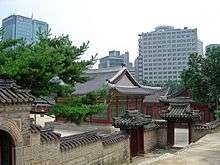Deoksugung
| Deoksugung | |
 | |
| Korean name | |
|---|---|
| Hangul | 덕수궁 |
| Hanja | 德壽宮 |
| Revised Romanization | Deoksugung |
| McCune–Reischauer | Tŏksugung |

Deoksugung, also known as Gyeongun-gung, Deoksugung Palace, or Deoksu Palace, is a walled compound of palaces in Seoul that was inhabited by members of Korea's royal family during the Joseon monarchy until colonial period around the turn of the 20th century. It is one of the "Five Grand Palaces" built by the kings of the Joseon Dynasty.[1] The buildings are of varying styles, including some of natural cryptomeria wood), painted wood, and stucco. Some buildings were built of stone to replicate western palatial structures.
In addition to the traditional palace buildings, there are also forested gardens, a statue of King Sejong the Great and the National Museum of Art, which holds special exhibitions. The palace is located near City Hall Station.
Deoksugung, like the other "Five Grand Palaces" in Seoul, was intentionally heavily destroyed during the colonial period of Korea. Currently, only one third of the structures that were standing before the occupation remain.[2]
Deoksugung Palace is special among Korean palaces. It has a modern and a western style garden and fountain. The Changing of the Royal Guard is in front of Daehanmun (Gate). It is a very popular event for many visitors. The royal guard was responsible for opening and closing the palace gate during the Joseon Dynasty. Outside of the palace is a picturesque road with a stone wall.[3]
History
Deoksugung was originally the residence of Prince Wolsan, the older brother of King Seongjong. This residence became a royal 'palace' during the Imjin war after all of the other palaces were burned in 1592 during the Imjin wars. King Seonjo was the first Joseon king to reside at the palace. King Gwanghaegun was crowned in this palace in 1608, and renamed it Gyeongun-gung (경운궁, 慶運宮) in 1611. After the official palace was moved to the rebuilt Changdeokgung in 1618, it was used as an auxiliary palace for 270 years and was renamed Seogung (West Palace).
In 1897, after the incident when Emperor Gojong took refuge in the Russian legation, he returned to this place and named it Gyeongungung again. Expansion of the facility followed after his return. After Emperor Gojong abdicated the throne to Emperor Sunjong, he continued to live in this palace. The palace was then renamed Deoksugung, as a reference to a wish for longevity of Emperor Gojong. Emperor Gojong died in Hamnyeongjeon.
National Museum of Modern and Contemporary Art, Deoksugung Branch
- Latin American Art: November 2008.[4]
Transportation
Deoksugung entry is located 5-1 Geongdong-gil/Deoksugung-gil, Jung-gu. The nearest subway station is
- City Hall Station (Station #132 on Line 1, Station #201 on Line 2).
References
- ↑ "The 5 Palaces of Seoul". Chosun Ilbo. 24 January 2012. Retrieved 23 April 2012.
- ↑ http://www.ohmynews.com/NWS_Web/view/at_pg.aspx?CNTN_CD=A0000068842
- ↑ "Deoksugung Palace". visit korea. Retrieved 16 November 2014.
- ↑ "Events Calendar" Korea Herald. 11 October 2008. Retrieved 2012-04-10
Bibliography
- Hoon, Shin Young (2008). The Royal Palaces of Korea: Six Centuries of Dynastic Grandeur (Hardback). Singapore: Stallion Press. ISBN 978-981-08-0806-8.
- Yoon, Jong-Soon (1992). Beautiful Seoul (Paperback). Seoul: Sung Min Publishing House.
Gallery
- Daehan Gate of the palace
- Junghwajeon, the main hall of Deoksu Palace
 The interior of the main hall
The interior of the main hall
 Bell
Bell
External links
| Wikimedia Commons has media related to Deoksugung. |
- Official guide from Cultural Heritage Administration
- Deoksu Palace
- Deoksugung : Official Seoul City Tourism
- The Seoul Guide : Deoksugung Palace
Coordinates: 37°33′58″N 126°58′29″E / 37.56618°N 126.97485°E
